Influence of the Periodicity of Sinusoidal Boundary Condition on the Unsteady Mixed Convection within a Square Enclosure Using an Ag–Water Nanofluid
Abstract
:1. Introduction
2. Problem Formulation
2.1. Physical Model
2.2. Thermophysical Property of the Nanofluid
2.3. Mathematical Modeling
3. Solution Procedure
3.1. Numerical Scheme
3.2. Grid Independency Test
3.3. Validationof the Code and Numerical Scheme
4. Results and Discussion
4.1. Effect of Even and Odd Frequencies on Streamlines Varying the Dimensionless Time
4.2. Effect of Even and Odd Frequencies on Isotherms Varying Dimensionless Time
4.3. Effect of Different Frequencies on Local Nusselt Number
4.4. Effect of Different Frequencies on Overall Nusselt Number for Different Grs
4.5. Correlation of Overall Nusselt Number for Different Frequencies and Different Grs
5. Conclusions
- •
- When the solid volume fraction is retained at 0.04, the convective heat transfer execution is improved.
- •
- Improving the Gr number is adequate to raise the convective heat transfer successfully.
- •
- At larger estimations of Gr, convection is exceptionally strong for lower estimations of frequencies for both even and odd values of N.
- •
- For smaller estimations of Gr, conduction is the primitive mode of heat transfer.
- •
- A higher value of Gr and lower values of N supports enhanced heat transfer through convection and conduction.
- •
- The overall Nusselt number at the heated surface rises with an increasing estimation of Gr.
Acknowledgments
Author Contributions
Conflicts of Interest
Nomenclature
| cp | specific heat (J kg−1 k−1) |
| g | gravitational acceleration (m s−2) |
| Gr | Grashof number |
| k | thermal conductivity (W m−1 k−1) |
| L | length of the enclosure (m) |
| Nu | Nusselt number |
| p | dimensional pressure (kg m−1 s−2) |
| P | dimensionless pressure |
| Pr | Prandtl number |
| T | fluid temperature (K) |
| t | dimensional time (s) |
| u | horizontal velocity component (m s−1) |
| U | dimensionless horizontal velocity component |
| v | vertical velocity component (m s−1) |
| V | dimensionless vertical velocity component |
| x | horizontal coordinate (m) |
| X | dimensionless horizontal coordinate |
| y | vertical coordínate(m) |
| Y | dimensionless vertical coordinate |
| k | thermal conductivity (W m−1 k−1) |
| Greek Symbols | |
| α | thermal diffusivity (m2 s−1) |
| β | thermal expansion coefficient (K−1) |
| δ | solid volume fraction |
| μ | dynamic viscosity (kg m−1 s−1) |
| υ | kinematic viscosity (m2 s−1) |
| τ | dimensionless time |
| θ | non-dimensional temperature |
| ρ | density (kg m−3) |
| ψ | stream function |
| λ | wave length |
| Γ | general dependent variable |
| Subscripts | |
| av | average |
| h | hot |
| c | cold |
| f | fluid |
| nf | nanofluid |
| s | solid nanoparticle |
| max | maximum |
| min | minimum |
References
- Omri, A.; Orfi, J.; Nasrallah, S.B. Natural convection effects in solar stills. Desalination 2005, 183, 173–178. [Google Scholar] [CrossRef]
- Rashidi, S.; Akar, S.; Bovand, M.; Ellahi, R. Volume of fluid model to simulate the nanofluid flow and entropy generation in a single slope solar still. Renew. Eng. 2018, 115, 400–410. [Google Scholar] [CrossRef]
- Fusegi, T.; Hyun, J.M.; Kuwahara, K.; Farouk, B. A numerical study of three dimensional natural convection in a differentially heated Cubical enclosure. Int. J. Heat Mass Transf. 1991, 34, 1543–1557. [Google Scholar] [CrossRef]
- Tzeng, S.C.; Liou, J.H.; Jou, R.Y. Numerical simulation-aided parametric analysis of natural convection in a roof of triangular enclosures. Heat Transf. Eng. 2005, 26, 69–79. [Google Scholar] [CrossRef]
- Chen, Q.; Wang, M.; Pan, N.; Guo, Z.-Y. Optimization principles for convective heat transfer. Energy 2009, 34, 1199–1206. [Google Scholar] [CrossRef]
- Esfahani, J.A.; Akbarzadeh, M.; Rashidi, S.; Rosen, M.A.; Ellahi, R. Influences of wavy wall and nanoparticles on entropy generation in a plate heat exchanger. Int. J. Heat Mass Transf. 2017, 109, 1162–1171. [Google Scholar] [CrossRef]
- Webb, R.L.; Kim, N.Y. Enhanced Heat Transfer; Taylor and Francis: New York, NY, USA, 2005. [Google Scholar]
- Incropera, F.P.; De Witt, D.P. Fundamentals of Heat and Mass Transfer; John Wiley & Sons, Inc.: New York, NY, USA, 1985. [Google Scholar]
- Xuan, Y.; Li, Q. Investigation on convective heat transfer and flow features of nanofluids. J. Heat Transf. 2003, 125, 151–155. [Google Scholar]
- Safaei, M.R.; Ahmadi, G.; Goodarzi, M.S.; Safdari Shadloo, M.; Goshayeshi, H.R.; Dahari, M. Heat transfer and pressure drop in fully developed turbulent flows of grapheme nanoplatelets-silver/water nanofluids. Fluids 2016, 1, 20. [Google Scholar] [CrossRef]
- Safaei, M.R.; Ahmadi, G.; Goodarzi, M.S.; Kamyar, A.; Kazi, S.N. Boundary layer flow and heat transfer of FMWCNT/water nanofluids over a flat plate. Fluids 2016, 1, 31. [Google Scholar] [CrossRef]
- Shirvan, K.M.; Mamourian, M.; Mirzakhanlari, S.; Ellahi, R. Numerical Investigation of Heat Exchanger Effectiveness in a Double Pipe Heat Exchanger Filled With Nanofluid: A Sensitivity Analysis by Response Surface Methodology. Powder Technol. 2017, 313, 99–111. [Google Scholar] [CrossRef]
- Ho, C.J.; Chung, Y.N.; Lai, C.-M. Thermal performance of Al2O3/water nanofluid in a natural Circulation loop with a mini-channel heat sink and heat source. Energy Convers. Manag. 2014, 87, 848–858. [Google Scholar] [CrossRef]
- Kang, Z.; Wang, L. Effect of thermal-electric cross coupling on heat transport in nanofluids. Energies 2017, 10, 123. [Google Scholar] [CrossRef]
- Asirvatham, L.G.; Vishal, N.; Gangatharan, S.K.; Lal, D.M. Experimental study on forced convective Heat transfer with low volume fraction of CuO/water nanofluid. Energies 2009, 2, 97–119. [Google Scholar] [CrossRef]
- Patil, M.S.; Kim, S.C.; Seo, J.-H.; Lee, M.-Y. Review of the thermo-physical properties and performance characteristics of a refrigeration system using refrigerant-based nanofluids. Energies 2016, 9, 22. [Google Scholar] [CrossRef]
- Patil, M.S.; Seo, J.-H.; Kang, S.-J.; Lee, M.-Y. Review on synthesis, thermo-physical property, and heat transfer mechanism of nanofluids. Energies 2016, 9, 840. [Google Scholar] [CrossRef]
- Khanafer, K.; Vafai, K.; Lightstone, M. Buoyancy-driven heat transfer enhancement in a two-dimensional enclosure utilizing nanofluids. Int. J. Heat Mass Transf. 2003, 46, 3639–3653. [Google Scholar] [CrossRef]
- Oztop, H.F.; Abu-Nada, E. Numerical study of natural convection in partially heated rectangular enclosure filled with nanofluids. Int. J. Heat Fluid Flow 2008, 29, 1326–1336. [Google Scholar] [CrossRef]
- Tiwari, R.K.; Das, M.K. Heat transfer augmentation in a two-sided lid-driven differentially heated square cavity utilizing nanofluids. Int. J. Heat Mass Transf. 2007, 50, 2002–2018. [Google Scholar] [CrossRef]
- Aminossadati, S.M.; Ghasemi, B. Natural convection cooling of a localized heat source at the bottom of a nanofluid-filled enclosure. Eur. J. Mech. B/Fluids 2009, 28, 630–640. [Google Scholar] [CrossRef]
- Mamourian, M.; Shirvan, K.M.; Ellahi, R.; Rahimi, A.B. Optimization of mixed convection heat transfer with entropy generation in a wavy surface square Lid-Driven cavity by means of Taguchi approach. Int. J. Heat Mass Transf. 2016, 120, 544–554. [Google Scholar] [CrossRef]
- Kim, J.; Kang, Y.T.; Choi, C.K. Analysis of convective instability and heat characteristics of nanofluids. Phys. Fluids 2004, 16, 2395–2401. [Google Scholar] [CrossRef]
- Hwang, K.S.; Lee, J.H.; Jang, S.P. Buoyancy-driven heat transfer of water-based Al2O3 nanofluids in a rectangular cavity. Int. J. Heat Mass Transf. 2007, 50, 4003–4010. [Google Scholar] [CrossRef]
- Santra, A.K.; Sen, S.; Chakraborty, N. Study of heat transfer characteristics of copper-water nanofluid in a differentially heated square cavity with different viscosity models. J. Enhanc. Heat Transf. 2008, 15, 273–287. [Google Scholar] [CrossRef]
- Ghanbarpour, M.; Nikkam, N.; Khodabandeh, R.; Toprak, M.S. Thermal performance of inclined screen mesh heat pipes using silver nanofluids. Int. Commum. Heat Mass Transf. 2015, 67, 14–20. [Google Scholar] [CrossRef]
- Abu-Nada, E.; Chamkha, A.J. Effect of nanofluid variable properties on natural convection in enclosures filled with a CuO-EG-Water nanofluid. Int. J. Therm. Sci. 2010, 49, 2339–2352. [Google Scholar] [CrossRef]
- Putra, N.; Roetzel, W.; Das, S.K. Natural convection of nanofluids. Heat Mass Transf. 2003, 39, 775–784. [Google Scholar] [CrossRef]
- Wen, D.; Ding, Y. Natural convective heat transfer of suspensions of titanium dioxide nanoparticles (nanofluids). IEEE Trans. Nanotechnol. 2006, 5, 220–227. [Google Scholar]
- Rahman, M.M.; Saha, S.; Mojumder, S.; Mekhilef, S.; Saidur, R. Numerical Simulation of Unsteady Heat Transfer in a Half Moon Shape Enclosure with Variable Thermal Boundary Condition for Different Nanofluids. Numer. Heat Transf. Part B Fundam. 2014, 65, 282–301. [Google Scholar] [CrossRef]
- Ho, C.J.; Chen, M.W.; Li, Z.W. Numerical simulation of natural convection of nanofluid in a square enclosure: Effects due to uncertainties of viscosity and thermal conductivity. Int. J. Heat Mass Transf. 2008, 51, 4506–4516. [Google Scholar] [CrossRef]
- Rahman, M.M.; Billah, M.M.; Hasanuzzaman, M.; Saidur, R.; Rahim, N.A. Heat transfer enhancement of nanofluids in a lid-driven square enclosure. Numer. Heat Transf. Part A Appl. 2012, 62, 973–991. [Google Scholar] [CrossRef]
- Abu-Nada, E.; Oztop, H.F. Effects of inclination angle on natural convection in enclosures filled with CuO-water nanofluid. Int. J. Heat Fluid Flow 2009, 30, 669–678. [Google Scholar] [CrossRef]
- Kahveci, K. Buoyancy driven heat transfer of nanofluids in a tilted enclosure. J. Heat Transf. 2010, 132, 62–74. [Google Scholar] [CrossRef]
- Shirvan, K.M.; Ellahi, R.; Mamourian, M.; Moghiman, M. Effect of Wavy Surface Characteristics on Heat Transfer in a Wavy Square Cavity Filled with Nanofluid. Int. J. Heat Mass Transf. 2017, 107, 1110–1118. [Google Scholar] [CrossRef]
- Lin, K.C.; Violi, A. Natural convection heat transfer of nanofluids in a vertical cavity: Effects of non-uniform particle diameter and temperature on thermal conductivity. Int. J. Heat Fluid Flow 2010, 31, 236–245. [Google Scholar] [CrossRef]
- Abu-Nada, E.; Masoud, Z.; Oztop, H.F.; Campo, A. Effect of nanofluid variable properties on natural convection in enclosures. Int. J. Therm. Sci. 2010, 49, 479–491. [Google Scholar] [CrossRef]
- Jou, R.-Y.; Tzeng, S.C. Numerical research of natural convective heat transfer enhancement filled with nanofluids in rectangular enclosures. Int. Commun. Heat Mass Transf. 2006, 33, 727–736. [Google Scholar] [CrossRef]
- Yu, Z. T.; Xu, X.; Hu, Y.C.; Fan, L.-W.; Cen, K.-F. Numerical study of transient buoyancy-driven convective heat transfer of water-based nanofluids in a bottom-heated isosceles triangular enclosure. Int. J. Heat Mass Transf. 2011, 54, 526–532. [Google Scholar] [CrossRef]
- Rahman, M.M.; Öztop, H.F.; Ahsan, A.; Saidur, R.; Al-Salem, K.; Rahim, N.A. Laminar mixed convection in inclined triangular enclosures filled with water based Cu nanofluid. Ind. Eng. Chem. Res. 2012, 51, 4090–4100. [Google Scholar] [CrossRef]
- Rahman, M.M.; Billah, M.M.; Rahman, A.T.M.M.; Kalam, M.A.; Ahsan, A. Numerical investigation of heat transfer enhancement of nanofluids in an inclined lid-driven triangular enclosure. Int. Commun. Heat Mass Transf. 2011, 38, 1360–1367. [Google Scholar] [CrossRef]
- Billah, M.M.; Rahman, M.M.; Razzak, M.A.; Saidur, R.; Mekhilef, S. Unsteady buoyancy-driven heat transfer enhancement of nanofluids in an inclined triangular enclosure. Int. Commun. Heat Mass Transf. 2013, 49, 115–127. [Google Scholar] [CrossRef]
- Rahman, M.M.; Saidur, R.; Mekhilef, S.; Uddin, M.B.; Ahsan, A. Double-diffusive buoyancy induced flow in a triangular cavity with corrugated bottom wall: Effects of geometrical parameters. Int. Commun. Heat Mass Transf. 2013, 45, 64–74. [Google Scholar] [CrossRef]
- Sheremet, M.A.; Pop, I.; Shenoy, A. Unsteady free convection in a porous open wavy cavity filled with a nanofluid using Buongiorno’s mathematical model. Int. Commun. Heat Mass Transf. 2015, 67, 66–72. [Google Scholar] [CrossRef]
- Rahman, M.M.; Öztop, H.F.; Steele, M.; Naim, A.G.; Al-Salem, K.; Ibrahim, T.A. Unsteady natural convection and statistical analysis in a CNT-water filled cavity with non-isothermal heating. Int. Commun. Heat Mass Transf. 2015, 64, 50–60. [Google Scholar] [CrossRef]
- Wu, W.-T.; Massoudi, M.; Yan, H. Heat Transfer and Flow of Nanofluids in a Y-Type Intersection Channel with Multiple Pulsations: A Numerical Study. Energies 2017, 10, 492. [Google Scholar] [CrossRef]
- Rashidi, S.; Esfahani, J.A.; Ellahi, R. Convective heat transfer and particle motion in an obstructed duct with two side-by-side obstacles by means of DPM model. Appl. Sci. 2017, 7, 431. [Google Scholar] [CrossRef]
- Sheikholeslami, M.; Zia, Q.M.Z.; Ellahi, R. Influence of induced magnetic field on free convection of nanofluid considering Koo-Kleinstreuer (KKL) correlation. Appl. Sci. 2016, 6, 324. [Google Scholar] [CrossRef]
- Ahmed, S.E.; Mansour, M.A.; Hussein, A.K.; Sivasankaran, S. Mixed convection from a discrete heat source in enclosures with two adjacent moving walls and filled with micropolar nanofluids. Eng. Sci. Technol. 2016, 19, 364–376. [Google Scholar] [CrossRef]
- Brinkman, H.C. The viscosity of concentrated suspensions and solutions. J. Cryst. Growth 1952, 20. [Google Scholar] [CrossRef]
- Wasp, F.J. Solid-Liquid Slurry Pipeline Transportation; Trans Tech Publications: Berlin, Germany, 1977. [Google Scholar]
- Batchelor, G.K. An Introduction to Fluid Dynamics; Cambridge University Press: London, UK, 1993. [Google Scholar]
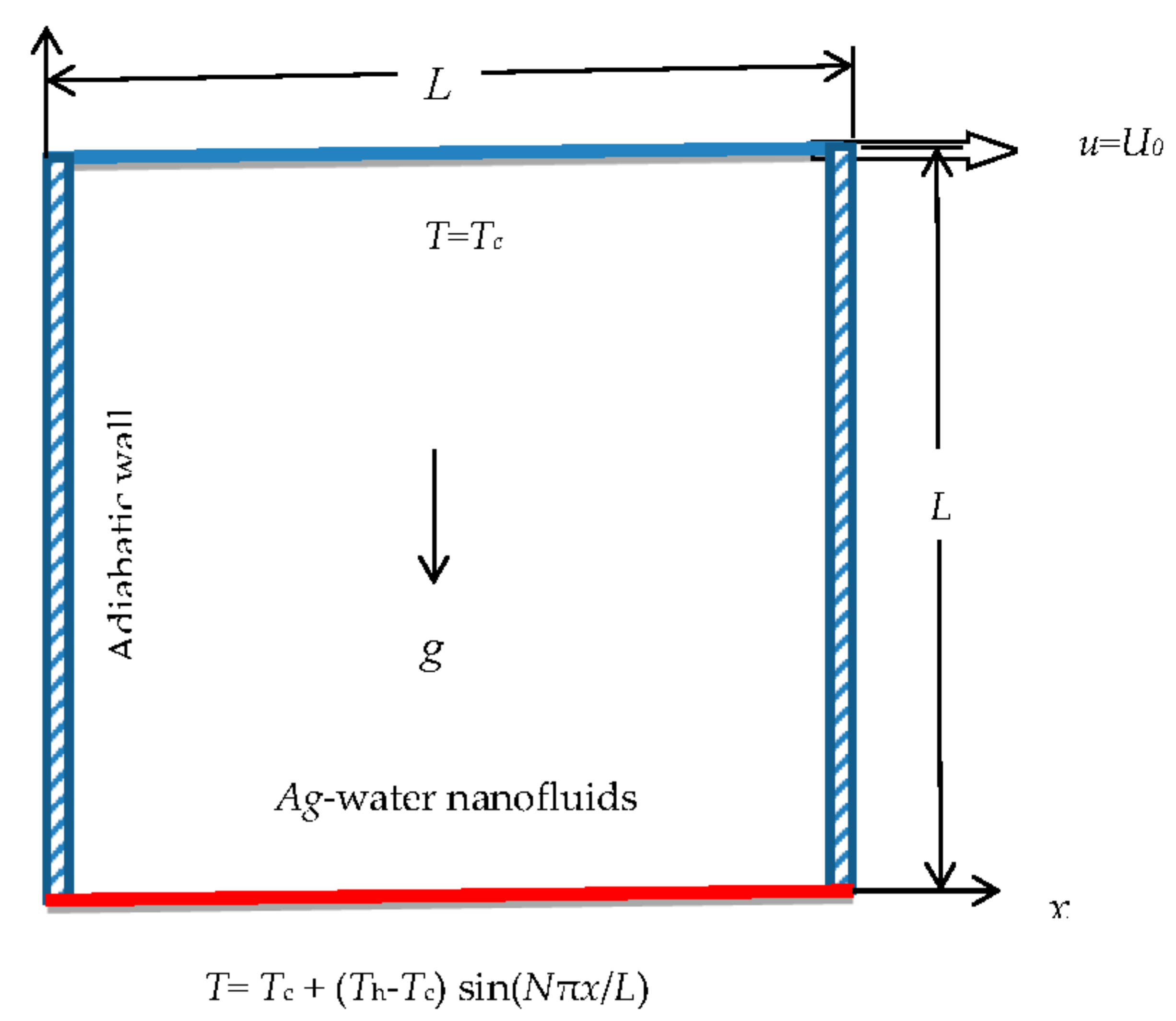
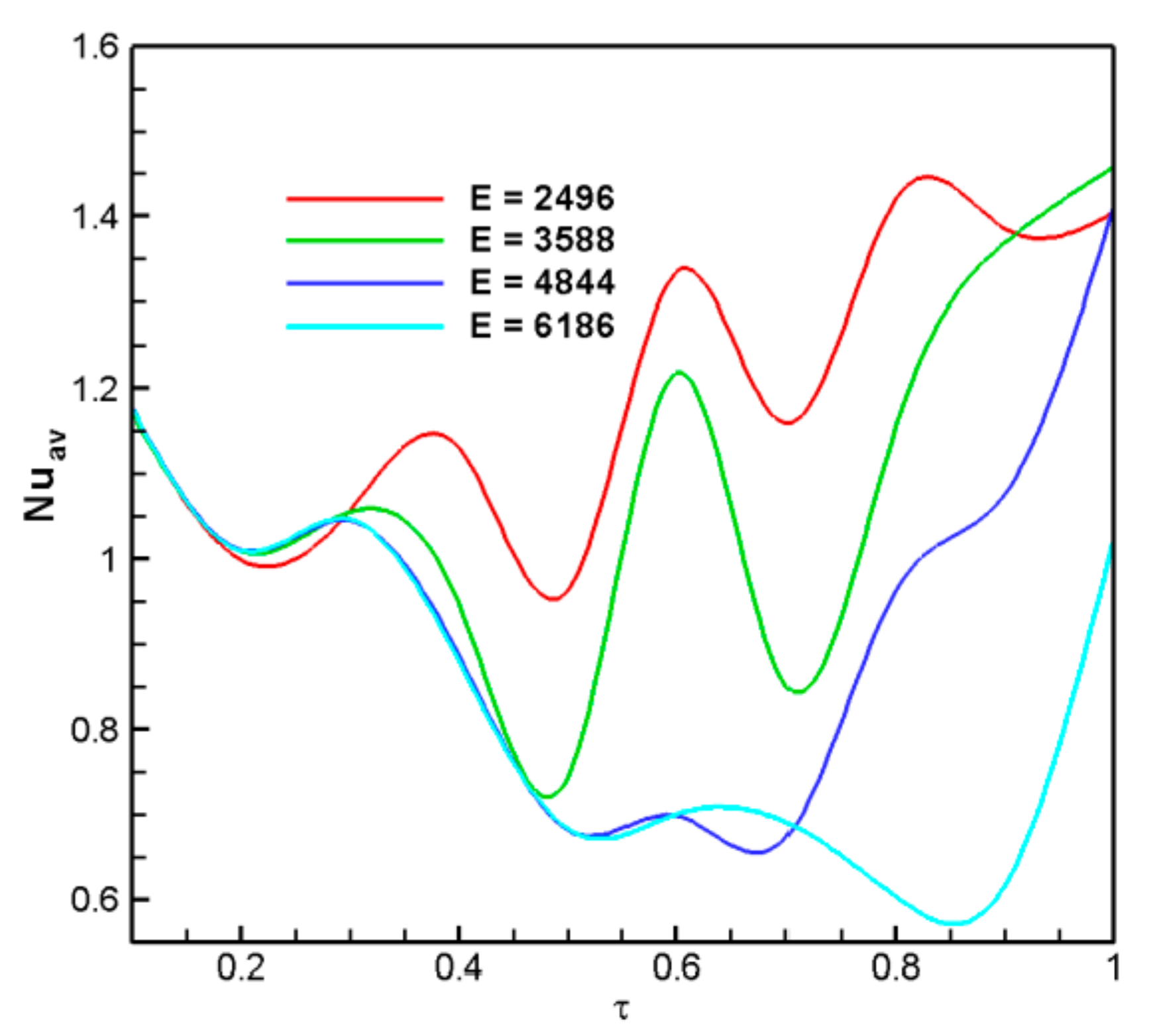
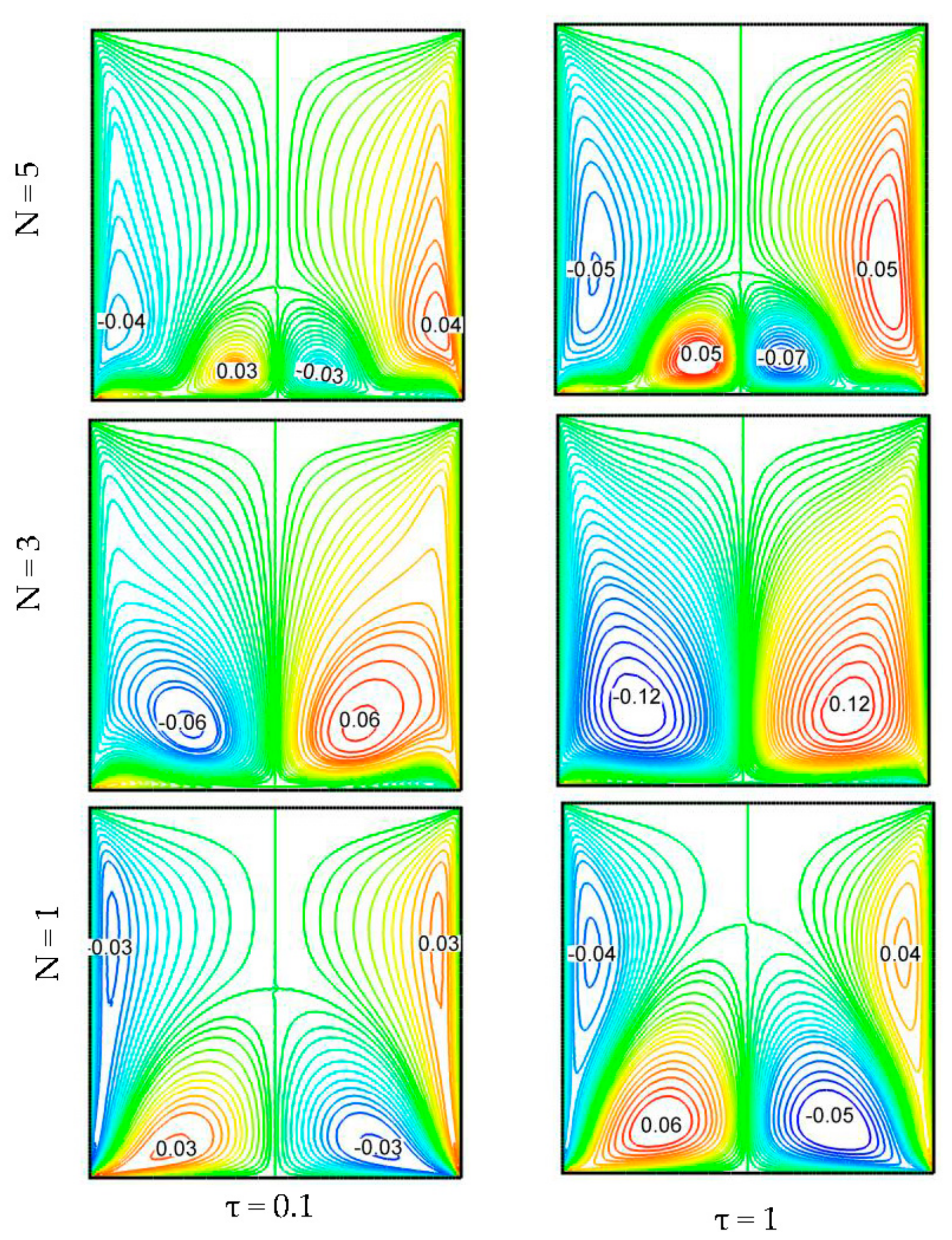
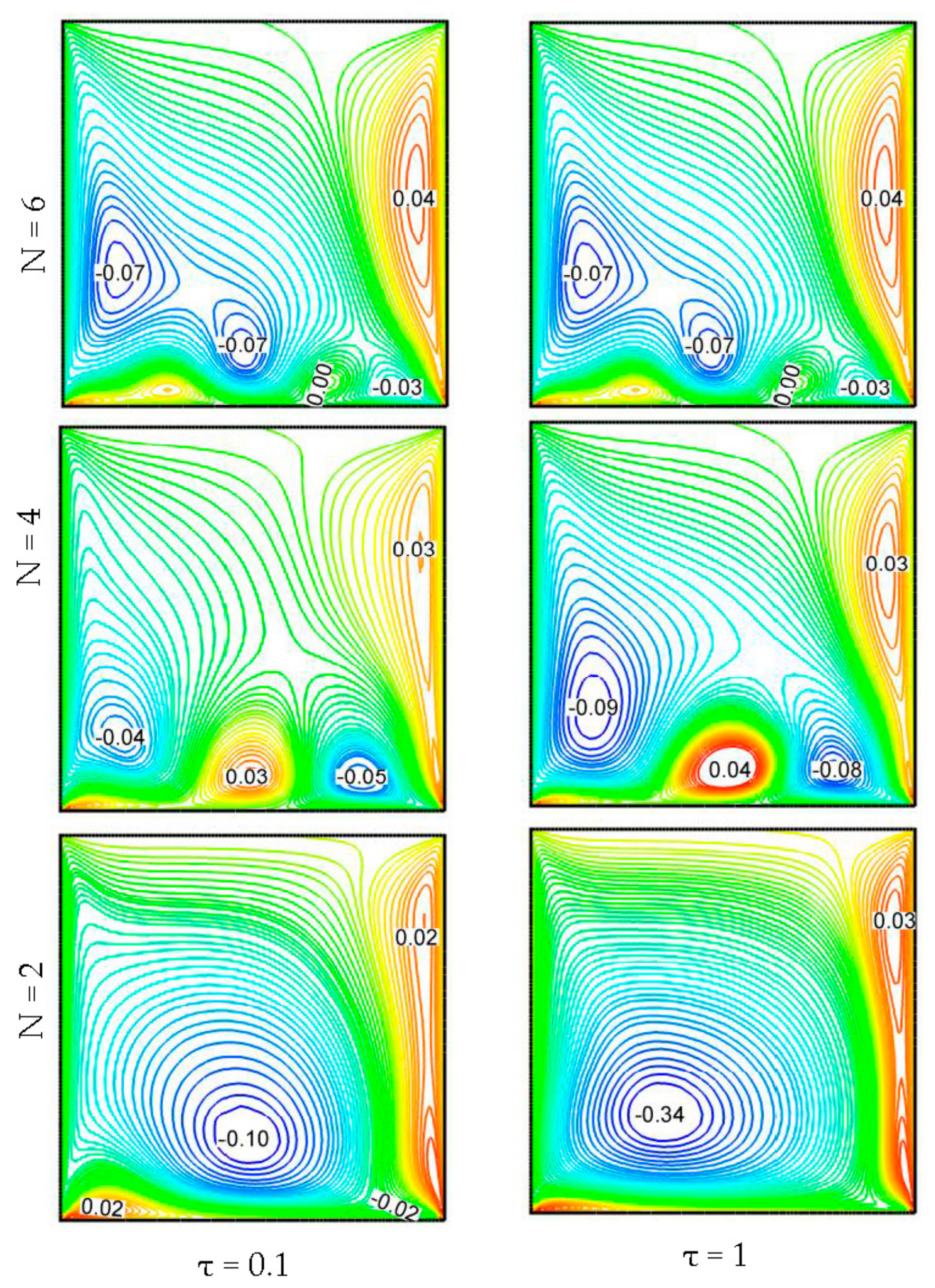
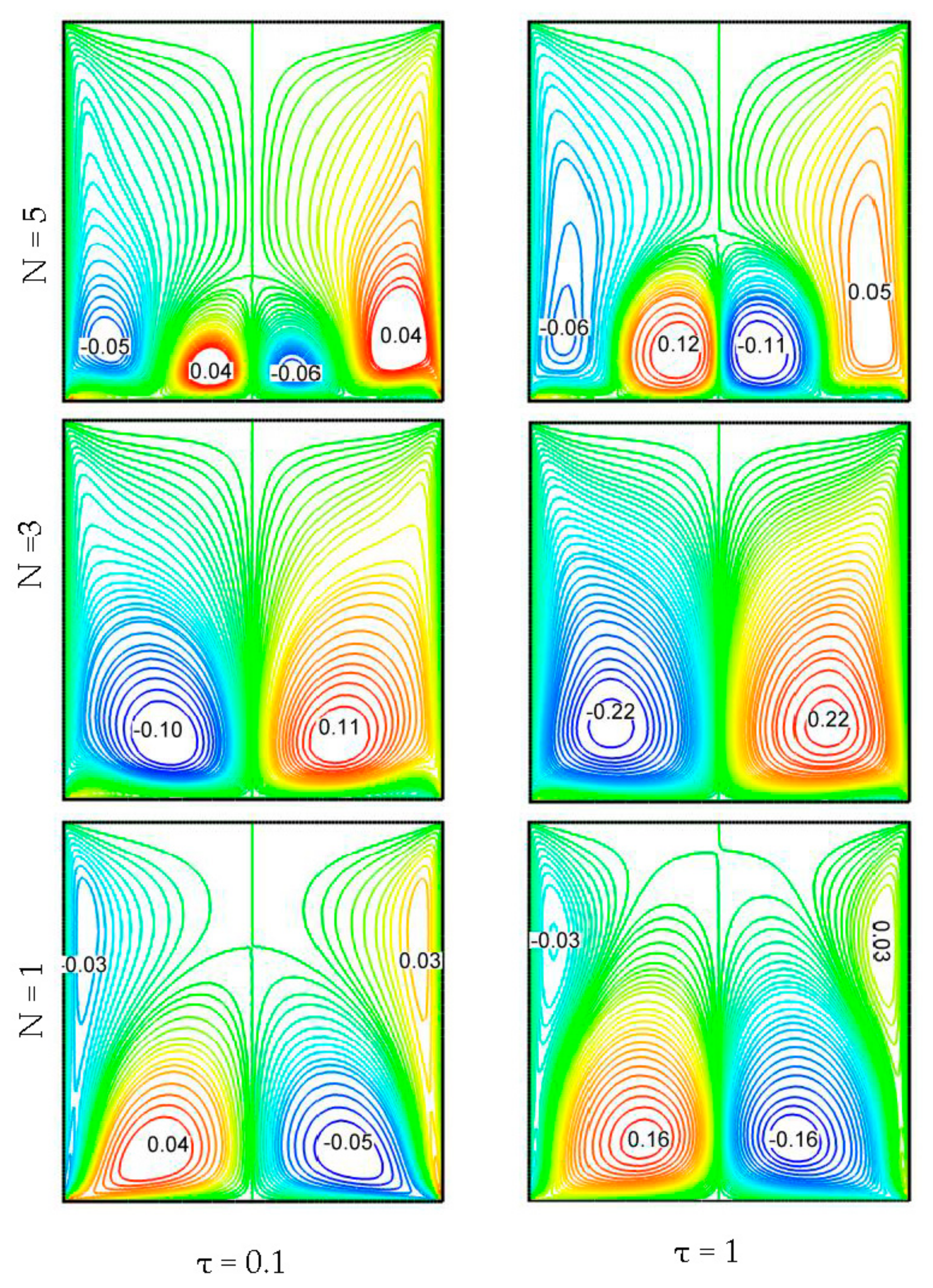
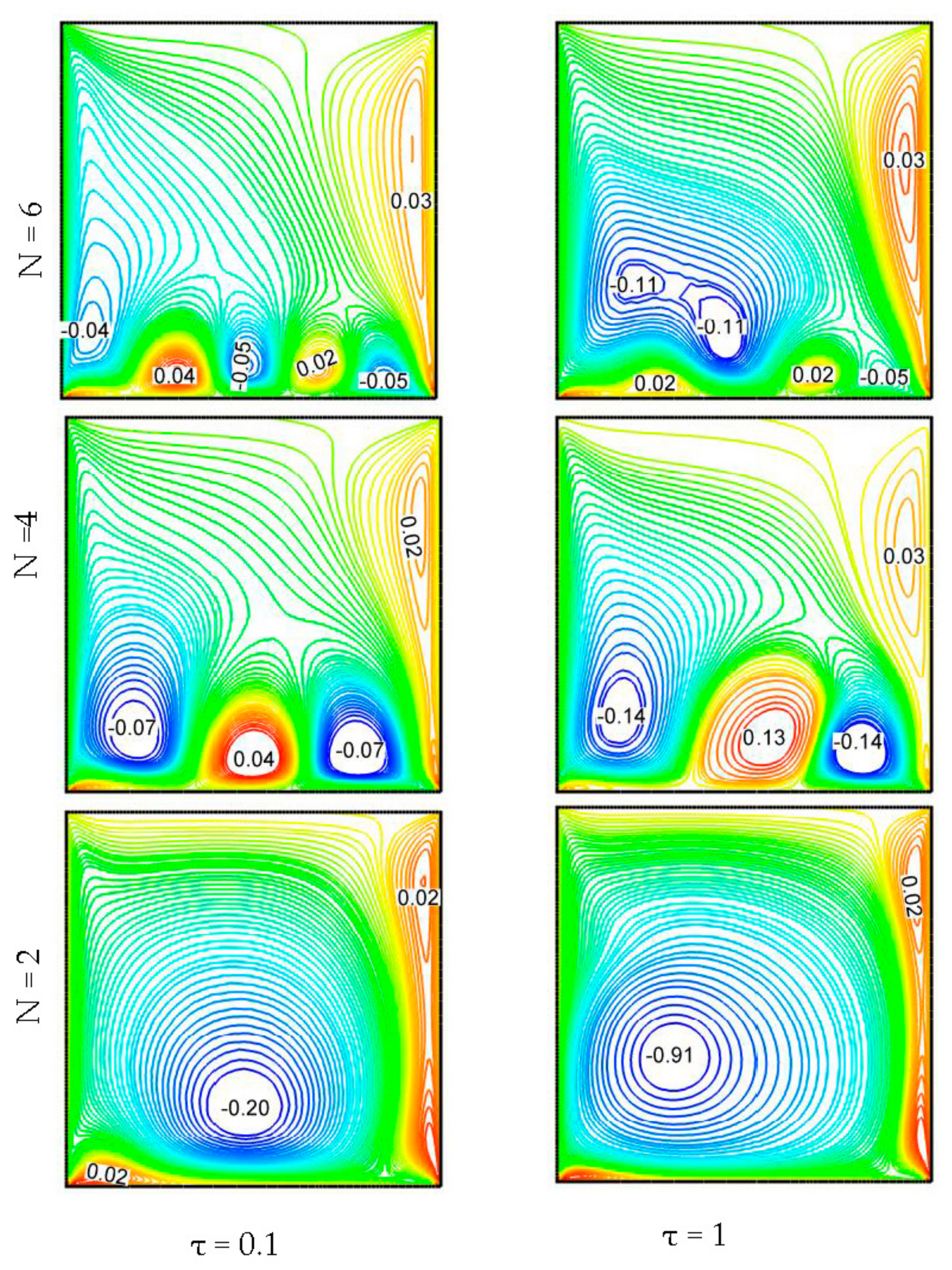
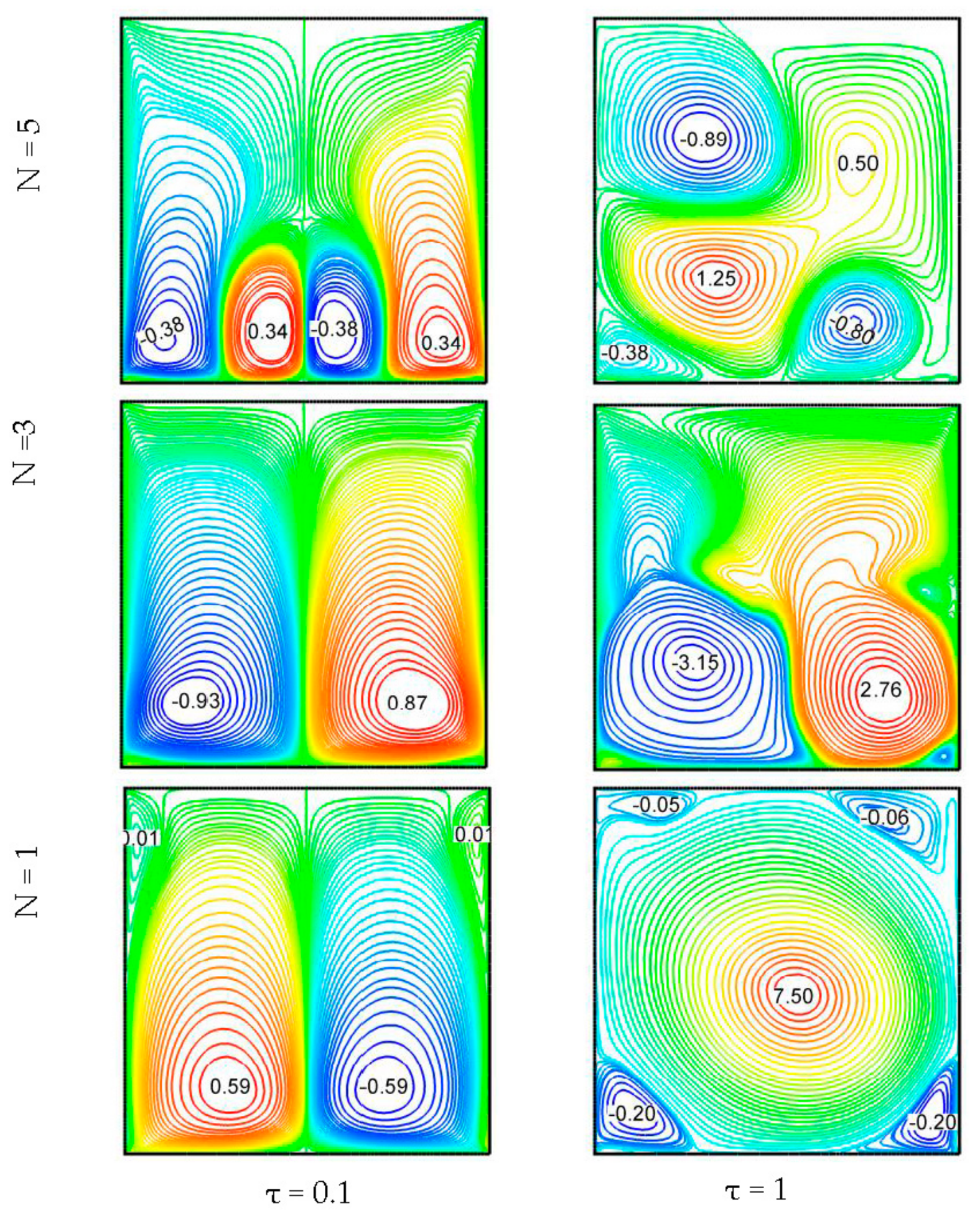
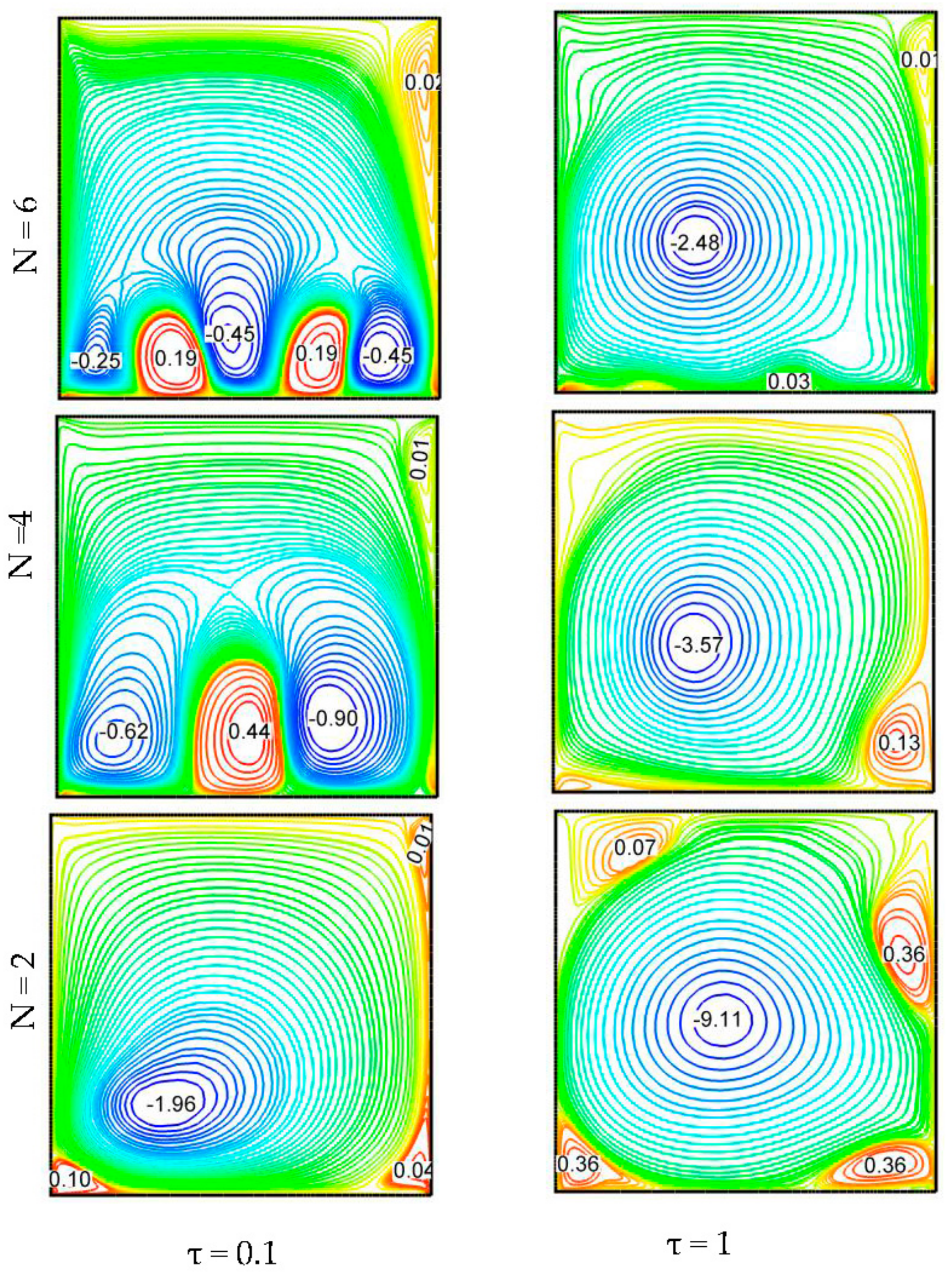
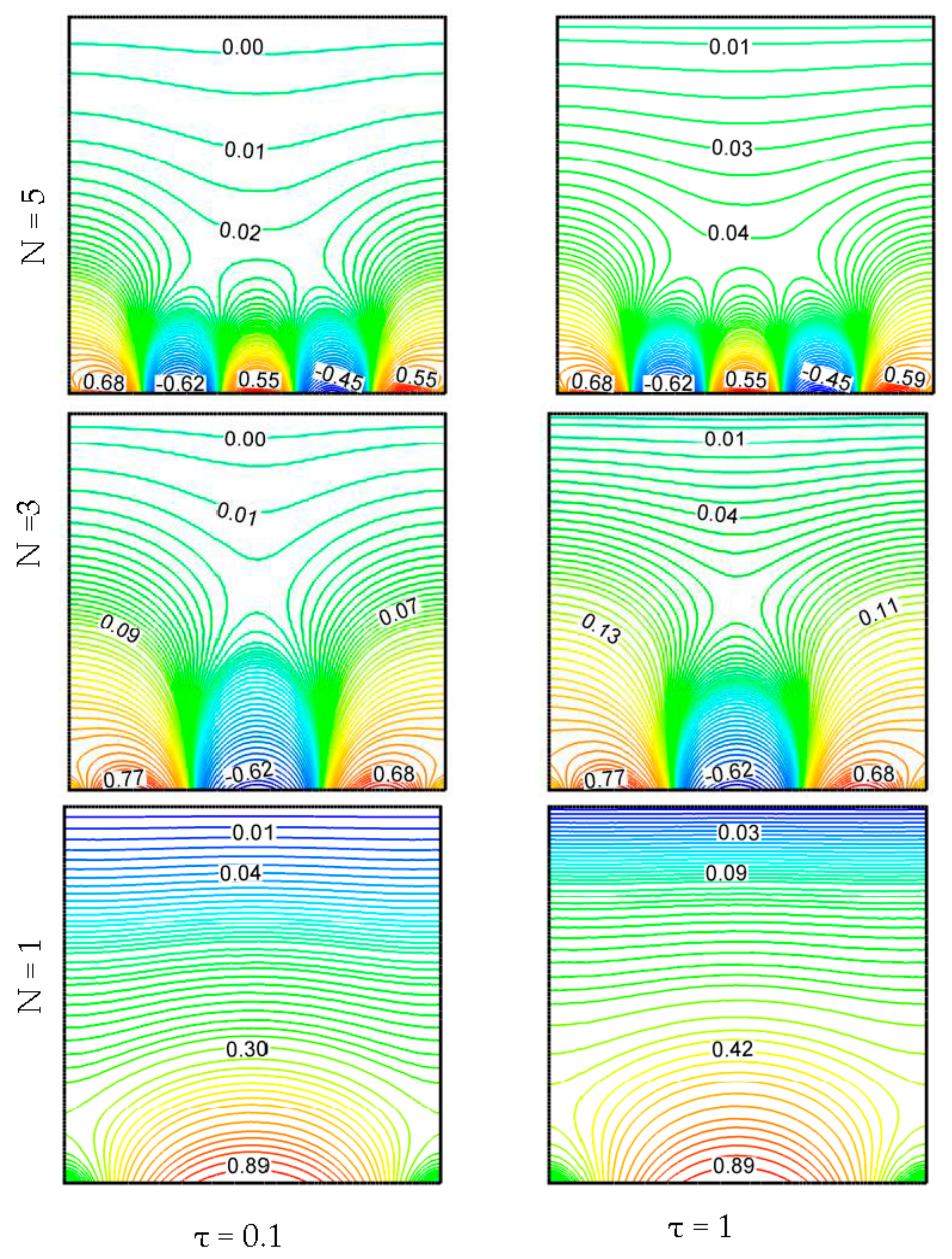
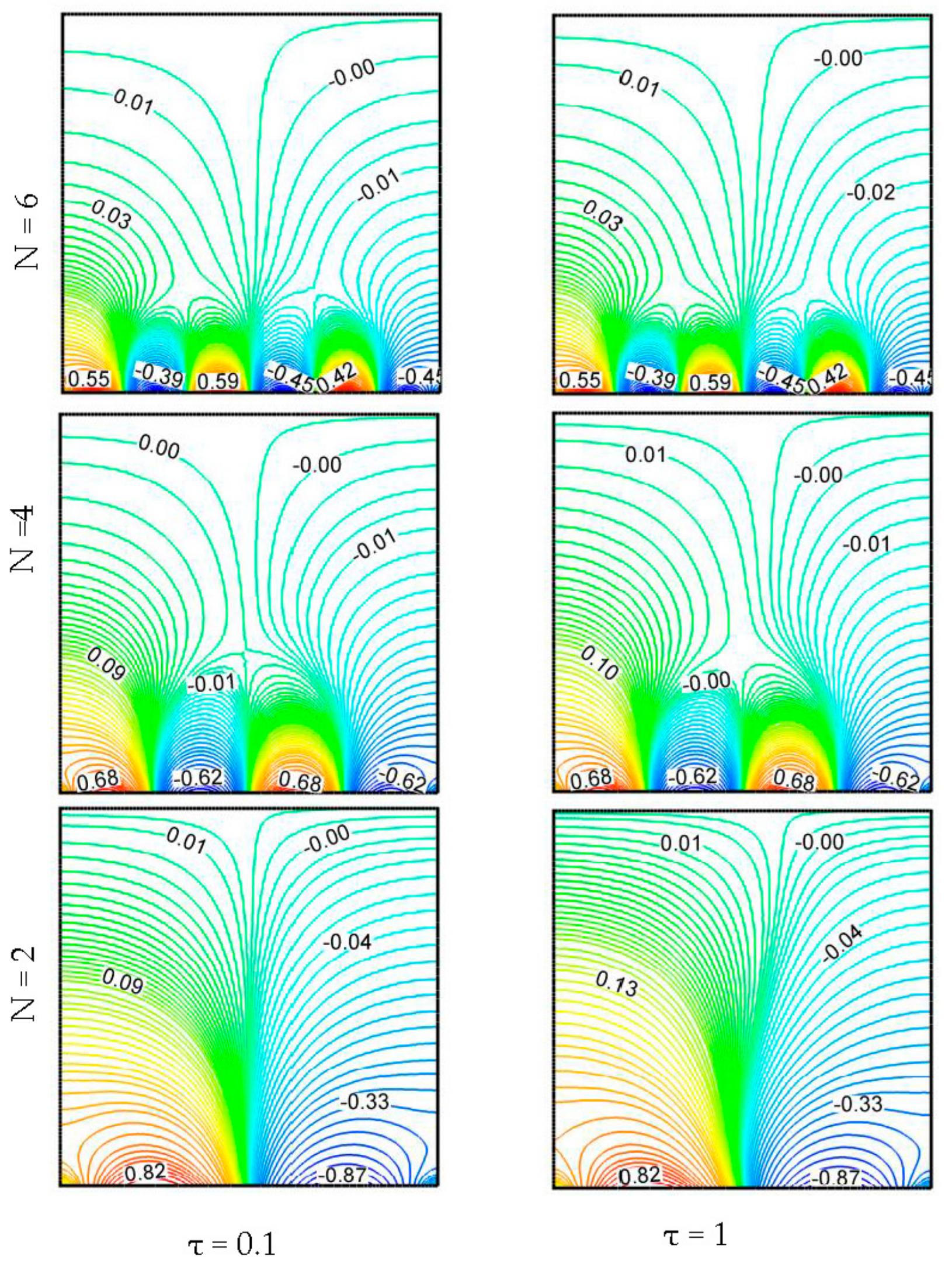
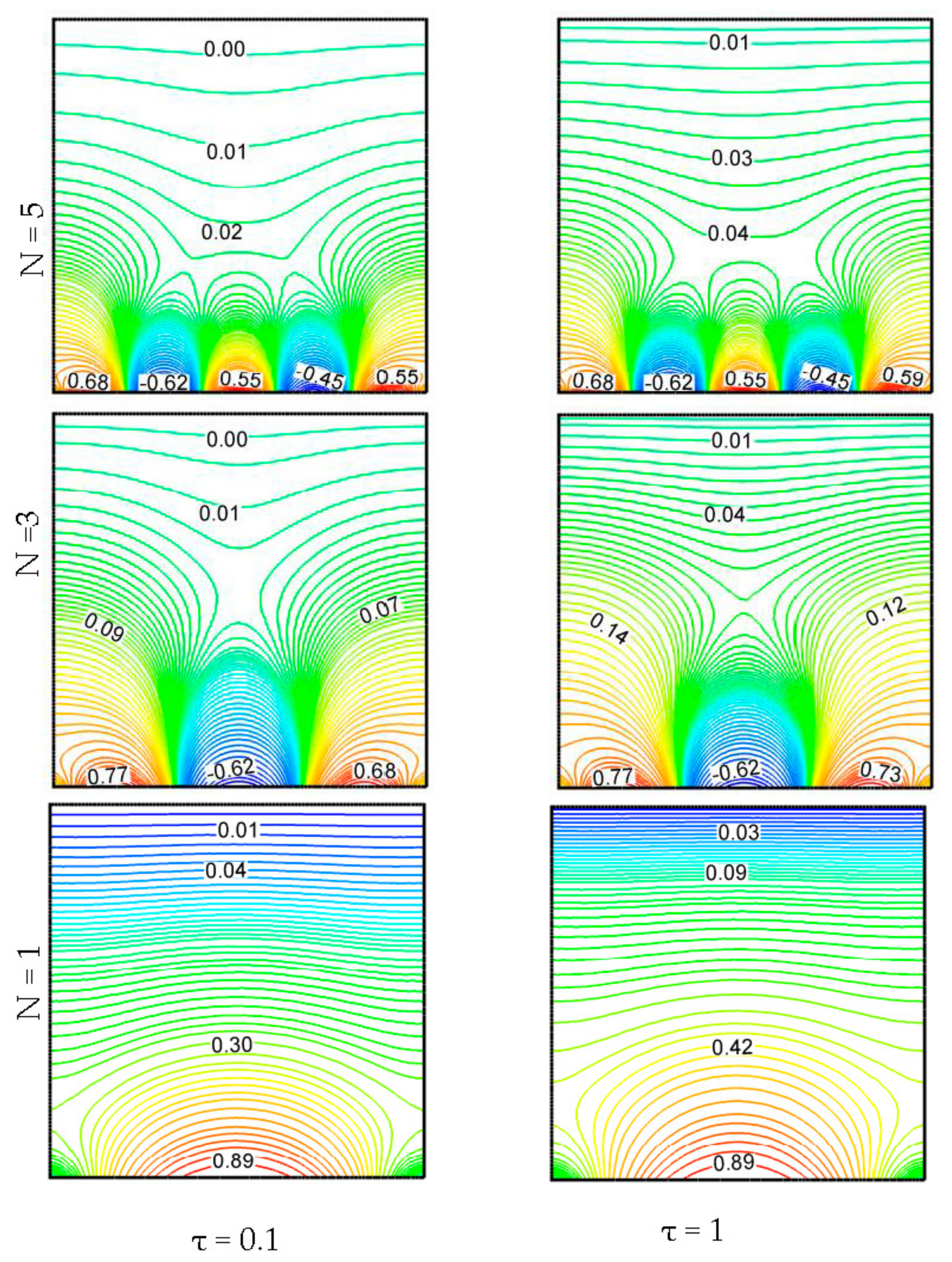


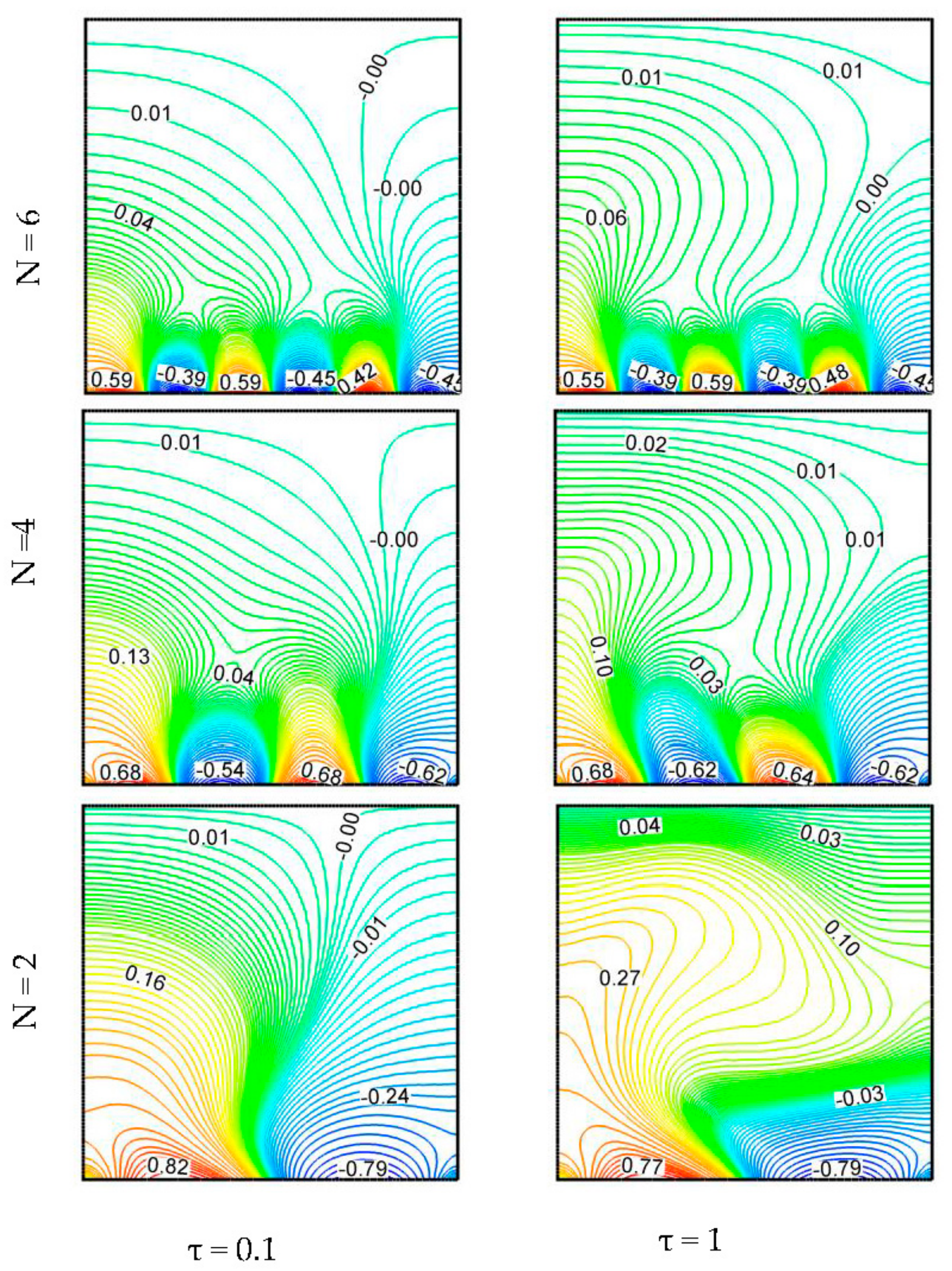
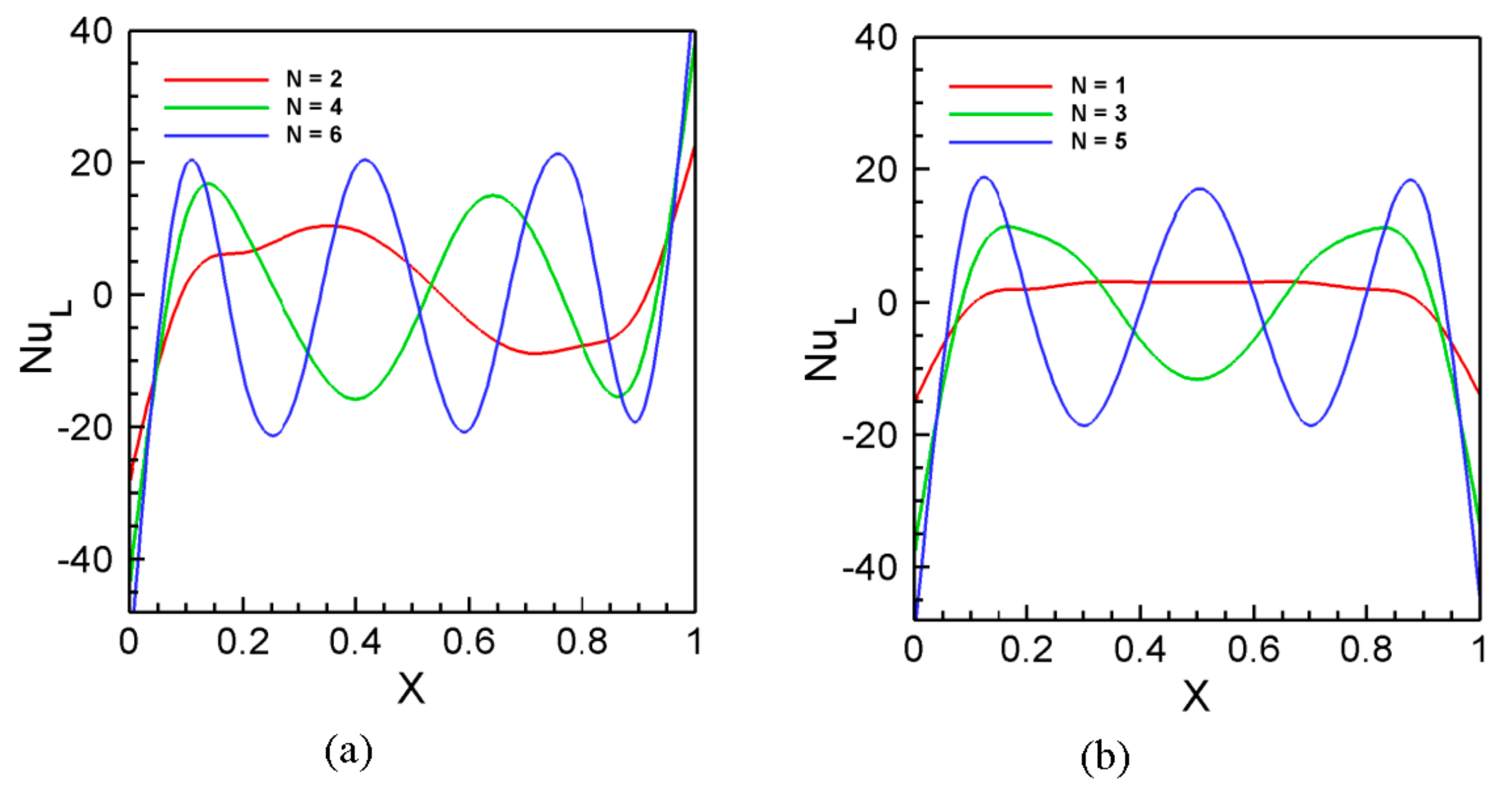
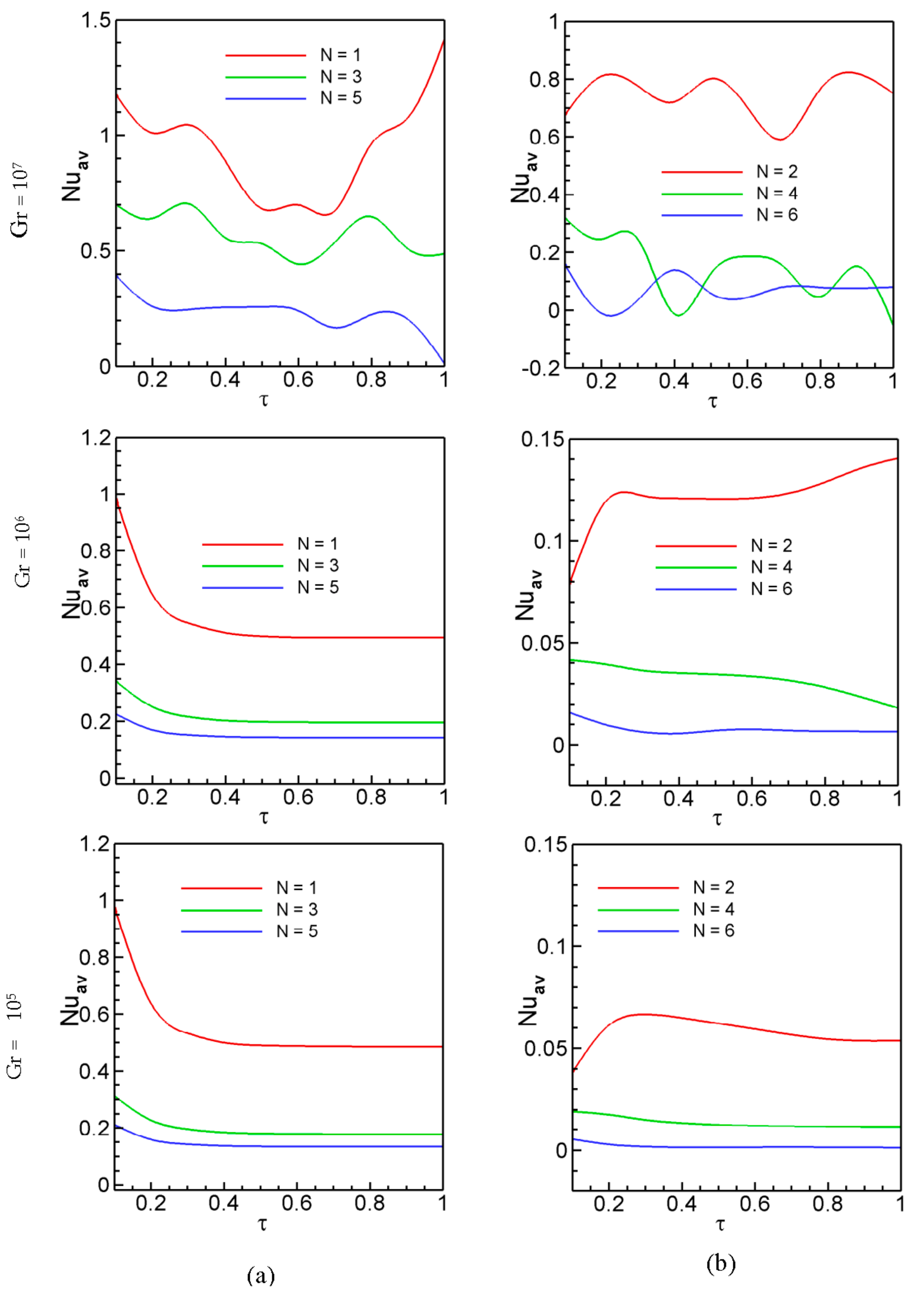
| Properties | Water | Ag |
|---|---|---|
| cp(J Kg−1 K−1) | 4179 | 235 |
| ρ(Kg m−3) | 997.1 | 10,500 |
| k(W m−1 K−1) | 0.613 | 429 |
| β(K−1) | 2.1 × 10−4 | 5.4 × 10−5 |
© 2017 by the authors. Licensee MDPI, Basel, Switzerland. This article is an open access article distributed under the terms and conditions of the Creative Commons Attribution (CC BY) license (http://creativecommons.org/licenses/by/4.0/).
Share and Cite
Karim, A.; Billah, M.M.; Newton, M.T.T.; Rahman, M.M. Influence of the Periodicity of Sinusoidal Boundary Condition on the Unsteady Mixed Convection within a Square Enclosure Using an Ag–Water Nanofluid. Energies 2017, 10, 2167. https://doi.org/10.3390/en10122167
Karim A, Billah MM, Newton MTT, Rahman MM. Influence of the Periodicity of Sinusoidal Boundary Condition on the Unsteady Mixed Convection within a Square Enclosure Using an Ag–Water Nanofluid. Energies. 2017; 10(12):2167. https://doi.org/10.3390/en10122167
Chicago/Turabian StyleKarim, Azharul, M. Masum Billah, M. T. Talukder Newton, and M. Mustafizur Rahman. 2017. "Influence of the Periodicity of Sinusoidal Boundary Condition on the Unsteady Mixed Convection within a Square Enclosure Using an Ag–Water Nanofluid" Energies 10, no. 12: 2167. https://doi.org/10.3390/en10122167
APA StyleKarim, A., Billah, M. M., Newton, M. T. T., & Rahman, M. M. (2017). Influence of the Periodicity of Sinusoidal Boundary Condition on the Unsteady Mixed Convection within a Square Enclosure Using an Ag–Water Nanofluid. Energies, 10(12), 2167. https://doi.org/10.3390/en10122167





